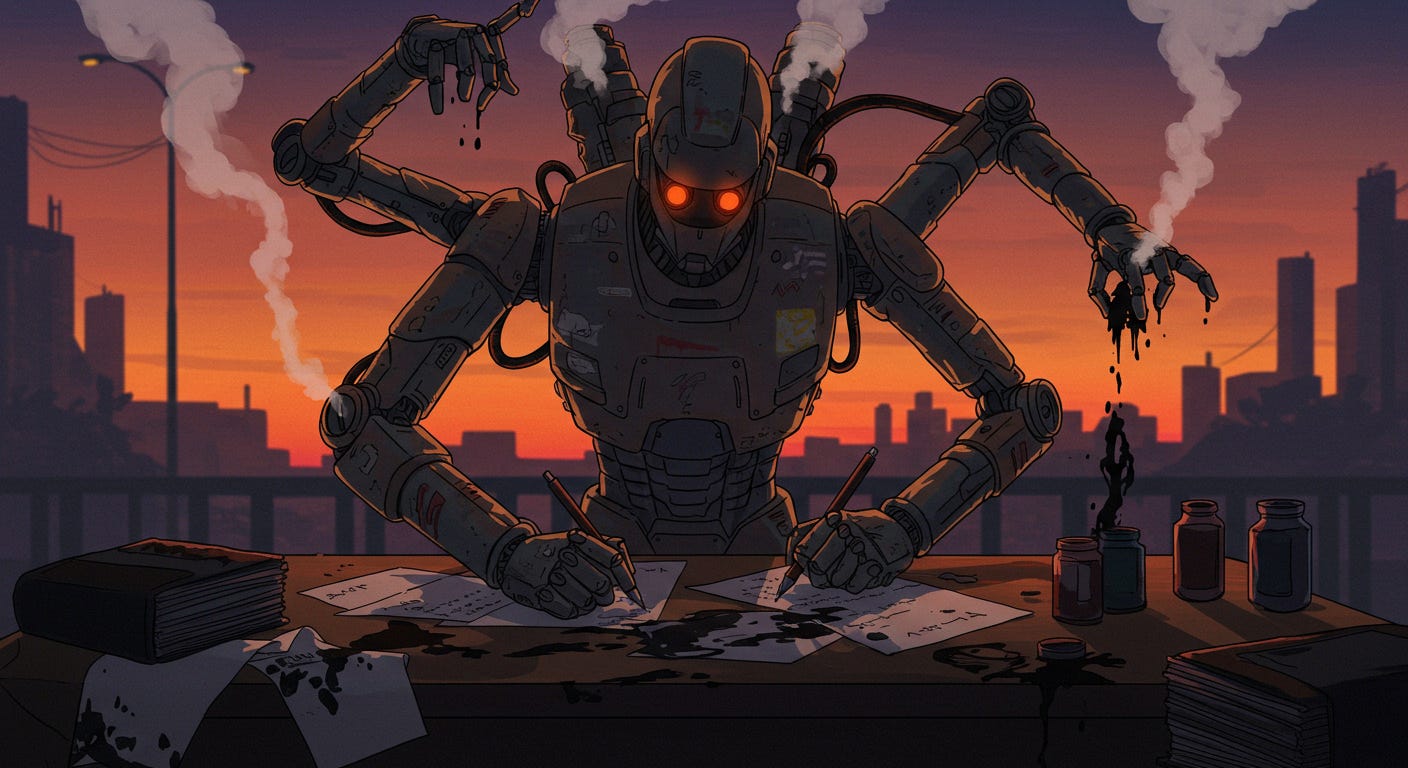Adapt or Go Bankrupt: How AI Content Writing Tools Are Changing the Game for Copywriters
The real threat isn't a sentient machine. It's the writer in the next cubicle - or, even more likely, the one sipping a cortado in Bali - who’s already figured this out.
Let's be honest. The romantic image of the writer agonizing over the perfect sentence in a quiet room? It's a myth, and it’s going extinct.
The relentless demand for speed, scale, and data-driven performance is shattering the old model. This isn't a future threat that's looming on the horizon; it's a present-day reality, and the engine of this revolution is AI content writing tools.
I’m not here to just review new tools; I’m here to rewire your thinking. The new rules of copywriting are about strategy, not just syntax. By the end of this article, you will have a clear, actionable framework for partnering with artificial intelligence in writing to produce higher-quality content faster, cementing your role as an irreplaceable creative strategist.
Key Takeaways (The ‘‘No Time to Waste’’ Section)
Rule #1: You’re the Architect, Not the Builder. Your job is strategy. AI is your new, tireless apprentice.
Rule #2: Speed Is a Weapon. AI eliminates the blank page, turning what Ann Handley calls "The Ugly First Draft" into a 10-minute task, not a 3-hour struggle.
Rule #3: The Final 10% Is All You. AI generates the raw clay. Your value is in the voice, the story, and the final polish that a machine can't replicate.
Rule #4: SEO Is a Science, Not a Guessing Game. The right AI tools transform optimization from a hunch into a data-driven process.
Table of Contents
Why Your ‘‘Tried-and-True’’ Process Is Broken
The New Playbook: Forging the Human-AI Partnership
Play #1: Killer of Traditional Brainstorming
Play #2: The AI Outline Architect
Play #3: The "Ugly First Draft" Accelerator
Play #4: The AI Rewriting Partner
Play #5: The SEO Optimization Engine
The Irreplaceable Human: Where AI Fails and You Dominate
You Still Have a Valid Reason to Be Paranoid
Why Your ‘‘Tried-and-True’’ Process Is Broken
For decades, the writer's process was a painful cycle of brainstorming, manual research, and fighting the blinking cursor. That model is officially broken. But that model is broken.
Why? Because the digital world now operates at a speed that human creativity alone can’t match.
Consider the data: As of 2023, over 70% of marketers were already actively using AI for content creation, according to a survey by Botco.ai. They’re not just experimenting; they’re deploying AI content automation to increase output and efficiency. While you’re agonizing over a headline, your competitor has already drafted, optimized, and scheduled three articles.
The old process, for all its romantic charm, is a horse-drawn carriage in the age of the supersonic jet. It's simply too slow.
The New Playbook: Forging the Human-AI Partnership
To thrive, stop thinking of yourself as just a writer. You're now a strategist, an editor, and a creative director armed with the most powerful assistant in history.
Here’s how you do it.
Play #1: Killer of Traditional Brainstorming
The Old Way: Brainstorming based on gut feelings and a few random Google searches.The New Way: Using a detailed, multi-layered prompt to make AI your strategic partner in brainstorming. The AI doesn't just spit out topics; it delivers fully-formed, data-aware content concepts ready for development.
Instead of guessing what your audience wants, you can know. While basic AI prompts give you generic lists, a "mega-prompt" transforms the AI from a simple idea vending machine into a strategic consultant. It provides deep context, sets constraints, and demands a sophisticated, structured output that forms the blueprint for your entire content plan.
Actionable Strategy: Using Google AI Studio to create a prompt that will later be fed into Google Gemini.
The goal is to give the AI a comprehensive brief, forcing it to think like a member of your team. Here is the result of the prompt we got:
‘‘Act as a world-class B2B SaaS Content Strategist and Market Research Analyst. Your expertise lies in creating content concepts that not only engage but also drive demand for a specific product.
1. My Company Context:
- Company: We are "SyncLead," a B2B SaaS platform.
- Product: Our tool uses AI to automate hyper-personalized lead nurturing sequences across email, LinkedIn, and SMS. It integrates with major CRMs like Salesforce and HubSpot.
- Unique Selling Proposition (USP): We move beyond generic "drip campaigns" by analyzing lead behavior in real-time to adjust messaging, timing, and channel, maximizing conversion rates.
- Brand Voice: Authoritative, data-driven, and slightly provocative. We challenge old marketing assumptions.
2. The Target Audience:
You will generate ideas for two distinct sub-personas of a "Marketing Manager":
- Persona A: "Strategic Sarah" (Director/VP Level): Cares about ROI, team efficiency, scaling processes, pipeline contribution, and proving marketing's value to the C-suite. She is post-implementation and thinks about systems.
- Persona B: "Tactical Tom" (Manager Level): Cares about campaign metrics (open/reply rates), improving MQL-to-SQL conversion, managing tools, and finding hands-on-keyboard efficiencies. He is in the weeds of execution.
3. The Core Task & Competitive Analysis:
- Your primary task is to generate 4 unique and sophisticated content angles about 'lead nurturing'. Before you do, perform a quick simulated analysis of the current content landscape.
- Identify and AVOID: Name 2-3 over-saturated, generic topics (e.g., "What is Lead Nurturing?", "5 steps to create a drip campaign").
- Identify and EXPLOIT: Identify 1-2 potential content gaps or advanced topics that are currently underserved.
4. Required Output Format:
For each of the 4 content angles, deliver the following in a structured, detailed breakdown:
- [Angle Title]: A compelling, non-generic headline. Should be benefit-oriented or challenging.
- [Target Persona]: "Strategic Sarah" or "Tactical Tom."
- [Funnel Stage]: Top of Funnel (TOFU), Middle of Funnel (MOFU), or Bottom of Funnel (BOFU).
- [Core Pain Point Addressed]: The deep professional anxiety this angle solves.
- [3 Secret Questions They're REALLY Asking]: Uncover their internal monologue.
- [Recommended Content Format]: Be specific (e.g., Data-driven report, Tear-down video, Interactive quiz).
- [SyncLead's Strategic Tie-in]: How does this content angle subtly position our product as the solution?
- [Competitive Justification]: Why is this angle superior to the generic content?’’Why is this prompt generated in Google AI Studio is more powerful?
Context-Aware Concepts: The AI now understands who is asking and what they sell. The ideas will be aligned with your specific product and brand voice.
Persona-Driven Angles: It moves beyond a single "marketing manager" to generate ideas tailored to different motivations (strategic vs. tactical).
Built-in Competitive Edge: Commanding the AI to first identify and avoid saturated topics forces it to a higher level of creativity. It's not just ideating; it's finding the blue ocean.
Strategic, Not Just Topical: Mapping each idea to a funnel stage and product tie-in turns a simple topic into a coherent part of your customer journey.
Actionable Formats: Asking for specific formats gives you tangible next steps. The idea isn't just "write about X," it's "create an interactive quiz about X."
Blueprint-Level Output: The detailed format for each idea leaves no room for lazy, one-line answers. The AI must deliver a well-reasoned, comprehensive concept that you can take directly to the outlining stage.
Play #2: The AI Outline Architect
The Old Way:Building an outline from scratch and hoping you covered everything.The New Way: A three-step process of extraction, analysis, and synthesis to engineer a structure built to rank from the ground up.
First, find the top 3-5 most authoritative articles on your topic.
Step 1: Extract the Building Blocks With Actionable Prompt:
‘‘I've pasted the text from 3 articles discussing the topic of 'AI for copywriting'. Act as an expert SEO analyst. Analyze this text and extract the most important semantic keywords, entities, and key phrases (e.g., 'content creation,' 'AI tools,' 'creative strategist,' 'first draft') that appear to be essential for demonstrating topical authority.’’Step 2: Analyze and Refine with SEO Tools
This is the crucial step where you validate your raw list against real-world data. Don't trust the AI's initial extraction blindly. Take your list of keywords and run it through a dedicated SEO content tool like SurferSEO, Semrush, or Ahrefs.
These tools will:
Provide Search Volume: Show you which terms people are actually searching for.
Identify Critical Terms: Highlight the must-have keywords that all top pages include.
Suggest More Opportunities: Uncover related keywords and questions you might have missed.
Step 3: Build A Rough Article Outline
Now, with your validated and refined list of keywords, you can confidently build a superior outline. This is the synthesis stage where you feed your final, data-driven assets back into the AI to construct the article's skeleton.
"Using the following data-driven list of keywords and entities, act as a world-class Content Strategist and create a comprehensive blog post outline for the title 'Why Your Lead Nurturing Fails (and How to Fix It)'
Validated Keywords: [Paste your final, refined list of keywords from your SEO tool here]
The outline must be structured logically with H2s and H3s. It should naturally incorporate the provided keywords and be designed to guide a reader from understanding the core problem to implementing a solution. Ensure the structure is comprehensive and flows well.Play #3: The ‘‘Ugly First Draft’’ Accelerator
The Old Way: The slow, agonizing process of writing a first draft from a simple outline.The New Way: Handing your AI a complete briefing package to generate a semantically rich first draft in minutes.
The fear of the blank page is a massive drain on creative energy. As writer Ann Handley says, you have to ‘‘Embrace The Ugly First Draft.’’
AI makes this step nearly frictionless, but the quality of your input determines the quality of your output. You aren't just ‘‘prompting for a draft’’; you are delivering a comprehensive creative brief that contains all the strategic assets you developed in the previous plays
Your briefing package has two key components:
The Blueprint: Your data-driven keywords from Play #2.
The Building Materials: Your article outline, also from Play #2.
You package these assets into a single, powerful prompt that leaves no room for error.
Actionable Prompt (The Briefing):
‘‘You are an expert B2B copywriter specializing in marketing technology. Your task is to write a ~1500-word draft for a blog post titled 'Why Your Lead Nurturing Fails (and How to Fix It)'
You will be given a precise outline and a list of essential keywords. Your job is to synthesize these assets into a coherent, authoritative, and engaging article for marketing managers.
1. Follow this exact outline: [Paste your detailed, AI-generated outline from Play #2, Step 3 here]
2. You MUST naturally incorporate the following essential keywords and phrases. Do not simply "stuff" them in. Weave them into the narrative to demonstrate deep topical authority. [Paste your validated, refined keyword list from your SEO tool in Play #2, Step 2 here]
Write in an authoritative but accessible tone that challenges old assumptions. Begin the draft now.’’Is the resulting draft perfect? God, no. But that’s the point. It's raw clay. The crucial difference is that this raw clay is already infused with the strategic and SEO DNA needed to succeed. This monumental leap in efficiency frees up your brainpower for the work that truly matters: the art of the rewrite.
Play #4: The AI Rewriting Partner
The Old Way: Rewriting is a lonely, solo process of trial and error.The New Way: Using AI as a relentless sparring partner to tighten, clarify, and elevate your prose.
Rewriting is the essence of writing well. It's where the magic happens. Here, AI isn't the writer; it's your sparring partner.
Actionable Strategy (The Zinsser Test on Steroids): William Zinsser famously urged writers to "strip every sentence to its cleanest components." Now, you can do this at scale. Take a clunky, jargon-filled paragraph from your draft and feed it to your AI with a simple prompt.
"Rewrite this paragraph to be clearer, more concise, and use a more active voice. Cut all clutter:"Before: ‘‘It has been observed that success in competitive situations is not always proportional to one's natural talent; therefore, it is necessary to consider the significant role that unpredictable elements play.’’
After AI: ‘‘A look at the world shows that the fastest don't always win the race and the strongest don't always win the fight. Success isn't guaranteed by talent; luck and chance play a big role.’’
The difference is clear. You are William Zinsser on steroids, stripping every sentence to its cleanest components with ruthless efficiency.
Play #5: The SEO Optimization Engine
The Old Way: Sprinkling in keywords and hoping for the best.The New Way: Using AI to optimize content for semantic search and topical authority.
Modern SEO is about topical relevance, not just keyword density. This is where specialized AI tools for SEO become indispensable. Platforms like SurferSEO analyze the top-ranking results for your target query and provide a data-driven list of semantically related terms and phrases you need to include to be considered an authoritative source on the topic. This is no longer guesswork; it's a science. AI content automation tools can then help you naturally weave these terms into your text, ensuring your article speaks Google's language without sounding robotic.
The Irreplaceable Human: Where AI Fails and You Dominate
If you've followed the playbook, you now have a well-researched, structured, drafted, and optimized article. But it's still missing the most important part: you. This is where you, the human copywriter, become invaluable. AI can't do this:
Voice, Tone, and Humanity: As the great writing teacher William Zinsser said, ‘‘your commodity as a writer... is you.’’ AI has no personality. It can't be witty, or vulnerable, or acerbic. It can't choose the perfect, unexpected word that makes a sentence sing. Your unique voice is your greatest defense. It's the core of Google's ‘‘E-E-A-T’’ (Experience, Expertise, Authoritativeness, Trustworthiness) guidelines - the human element that builds real trust.
Strategic Storytelling and True Empathy: AI can arrange facts. It cannot feel a customer's pain. It cannot weave a personal anecdote into a compelling narrative that builds a genuine emotional bridge with the reader. That is a fundamentally human art.
The Brave Angle and Genuine Originality: AI synthesizes what already exists. It follows patterns. It cannot, by its very nature, create a truly new, controversial, or paradigm-shifting idea. That spark of rebellious genius - the ‘‘Adapt or Die’’ angle itself - can only come from a human mind.
This is also where we must remember what happens when we treat an AI's output as the final product. In early 2023, the tech site CNET was caught publishing dozens of AI-generated articles on financial topics that were filled with factual errors, plagiarism, and ‘‘stilted language.’’ The backlash was immediate and severe, forcing the company to issue major corrections and damaging its credibility. This event is the ultimate cautionary tale: AI is a powerful engine, but a human must always be in the driver's seat to check the facts and guide the narrative.
You Still Have a Valid Reason to Be Paranoid
Ignore the doomsday preppers hoarding canned goods and fearing the robot apocalypse. AI isn't the terminator coming for your copywriting job. Think of it as the ridiculously powerful, slightly unhinged, wildly creative co-pilot who just climbed into your cockpit. It needs you to tell it where to go.
The real threat isn't a sentient machine. It's the writer in the next cubicle - or, even more likely, the one sipping a cortado in Bali - who’s already figured this out.












